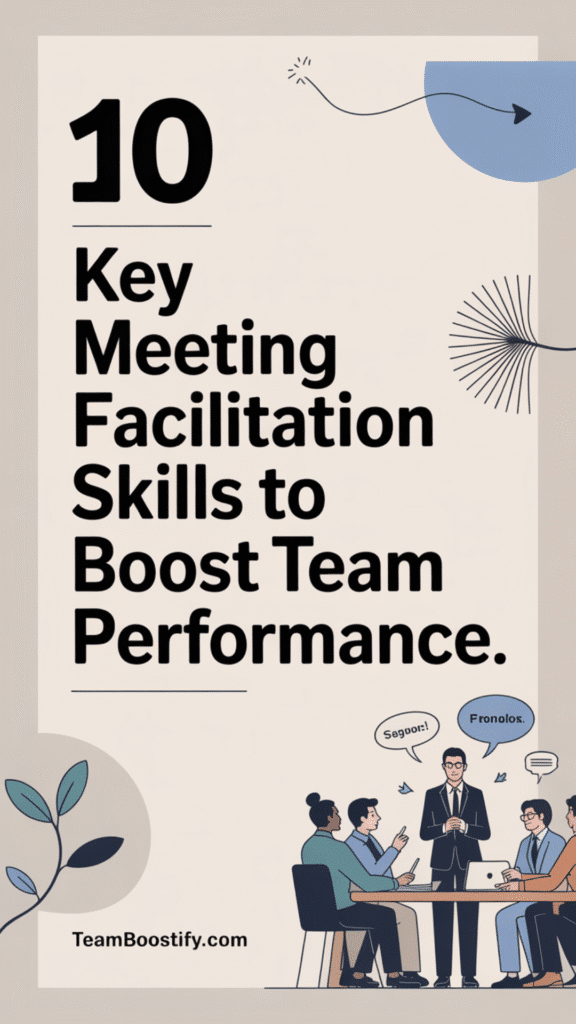Project teams spend a big part of their week in meetings (how many hours I’ve spent in them over the past 20 years as a PM, I honestly don’t even want to count).
And while some meetings move things forward, others… not so much.
Sometimes they go in circles, end without clear next steps, or leave people wondering what the point was. It happens – even on well-managed projects.
What could help make meetings more effective? Meeting facilitation skills – a set of practical tools that can turn conversations into something much more useful: a way to build clarity, support engagement, and improve how the team works together.
Let’s break down 10 of those skills – practical, repeatable, and worth using every week.
Table of Contents
1. Define the Purpose Before You Invite Anyone
One of the most underrated meeting facilitation skills is simply knowing why you’re meeting in the first place.
Too many meetings happen out of habit – a weekly sync, a status update, a “quick check-in” – without a clear outcome in mind. That’s how you end up with passive participants, side conversations, and zero follow-through.
Strong facilitators (yes, even project managers) define the purpose of the meeting before sending invites. Ask yourself:
- What decision needs to be made?
- What input is needed – and from whom?
- What does success look like by the end of this meeting?
Once you’re clear on those answers, share them upfront. It sets expectations, reduces confusion, and gives people a reason to actually show up and contribute.
A simple formula:
“By the end of this meeting, we will have ___.”
Try it in your next invite – it changes everything.
This skill alone can drastically improve engagement and save hours every week.
If you’re working on your meeting facilitation skills, start here. It’s low-effort, high-impact, and immediately noticeable to your team.
2. Create a Safe Space for Open Input
If your team’s holding back, your meetings are underperforming – no matter how good your agenda is.
One of the most impactful meeting facilitation skills is the ability to create psychological safety. That means people feel comfortable sharing real concerns, raising red flags, or simply saying “I don’t get it” – without fear of being judged, talked over, or ignored.
Without this, meetings become a performance. People nod along. Real issues stay hidden until they explode later in the project.
Facilitators (especially project managers) can set the tone early. A few powerful moves:
- Normalize uncertainty: say “We don’t have to have all the answers today.”
- Ask for unseen perspectives: “What haven’t we said out loud yet?”
- Validate contribution, not correctness.
It’s not about turning meetings into therapy. It’s about making space for honesty and clarity – which directly impacts decision-making and trust.
Teams that feel safe speak up earlier, solve problems faster, and collaborate more effectively. And that’s exactly the kind of performance boost project managers need.
Mastering this one move will level up your meeting facilitation skills – and shift the dynamic in every room you lead.
3. Use a Structured Agenda – and Stick to It
Agendas aren’t just for show – they’re one of the simplest, highest-leverage meeting facilitation skills you can build.
Without structure, meetings drift. People jump between topics, dominate airtime, or go down rabbit holes. With structure, you create focus, rhythm, and shared expectations. Everyone knows why they’re there and what’s coming next.
The key isn’t just having an agenda – it’s making it clear and time-bound:
- List each topic with a time estimate
- Clarify what’s needed (e.g. discussion, decision, update)
- Assign a “driver” for each section, if possible
For example:
Agenda
- Quick Wins Review – 5 min (update)
- Roadmap Blockers – 10 min (discussion)
- Feature Prioritization – 15 min (decision)
- Action Items Recap – 5 min (wrap-up)
When people see structure, they feel more confident contributing. They also respect the time because they can see it being respected.
Project managers who use structured agendas consistently are seen as more organized, decisive, and clear-headed. Not bad for something that takes 5 minutes to prep.
If you’re serious about sharpening your meeting facilitation skills, get disciplined with your agenda. It sets the tone before you even say a word.
4. Facilitate Equal Participation
If the same three people talk in every meeting, you’re not getting the full picture – you’re just getting repetition.
One of the most valuable meeting facilitation skills is making space for everyone’s voice, not just the most vocal or senior. This doesn’t mean forcing introverts to speak up – it means designing the flow so all types of contributors can engage meaningfully.
Why it matters:
- Better ideas emerge when more brains are involved
- Engagement goes up when people feel heard
- Team ownership grows when everyone contributes
Simple facilitation tactics to use:
- Silent brainstorming: Have people write ideas individually before group discussion
- Round-robin sharing: Go around the (virtual or real) table to check in
- 1-2-4-All: Start solo, then pair up, then share in groups – works great for problem-solving
- Voting tools: Let people anonymously weigh in before discussion
You don’t need fancy tech to make this work. You just need to intentionally design for inclusion.
When team members consistently feel invited in – not just tolerated – performance improves across the board.
Want to upgrade your meeting facilitation skills fast? Stop managing airtime. Start creating shared space.
5. Clarify Roles in Real Time
Meetings without role clarity create one predictable outcome: nothing happens afterward.
You leave with “great discussion,” but no one knows who’s doing what. Tasks fall through the cracks. Deadlines get missed. And suddenly the meeting was just a very expensive conversation.
One of the most underrated meeting facilitation skills is the ability to turn abstract plans into clear ownership – right there in the room.
Here’s how to do it:
- When an action or decision comes up, stop and ask: “Who owns this next step?”
- Follow with: “By when?” and “What does done look like?”
- Don’t assume – confirm and write it down (on screen if possible)
You don’t need a full-blown RACI chart, but knowing who’s responsible, accountable, consulted, and informed can eliminate tons of friction.
Bonus move: assign a “note-taker” or “decision tracker” at the start of the meeting – this keeps outcomes visible and prevents backtracking later.
Project managers who get clear on roles during the meeting avoid 90% of follow-up chaos.
When you’re sharpening your meeting facilitation skills, start treating role clarity like a non-negotiable. Your team (and future self) will thank you.
6. Balance Divergence and Convergence
Every effective meeting moves through two essential phases: divergence (opening up ideas, perspectives, or options) and convergence (narrowing focus, making decisions, or setting direction).
One of the more advanced – but powerful – meeting facilitation skills is knowing when to stay open and when to push for alignment. Most meetings get stuck by mixing these phases or skipping one entirely.
Here’s what that can look like:
- A team starts generating ideas but gets forced into deciding too quickly – innovation shuts down.
- A group keeps circling possibilities without ever committing – fatigue sets in, and nothing moves forward.
Facilitators (including project managers) can guide the room by naming where they are in the process:
“Let’s stay in divergence for a few more minutes – gather all options.”
“Okay, time to converge – what are our criteria for making this decision?”
You can even structure the meeting into clear blocks:
- Explore → 15 min
- Discuss → 10 min
- Decide → 5 min
This helps participants stay grounded and reduces frustration from unclear expectations.
Teams feel more confident when they know where the conversation is headed – and why. That’s the kind of flow great meeting facilitation skills create.
7. Use Visual Tools to Keep Focus
Talking isn’t thinking – at least, not for everyone on your team.
One of the most effective meeting facilitation skills is knowing when to get ideas out of heads and onto something visual. Whether it’s a whiteboard, shared doc, sticky notes, or a Miro board, visuals help structure the chaos and keep people engaged.
Here’s why it works:
- Visuals reduce cognitive load – you don’t have to remember everything that was said
- They help participants track progress in real time
- They clarify abstract ideas – especially useful for remote/hybrid teams
Practical tools to use:
- Real-time agenda + notes (Google Docs, Notion)
- Decision boards (simple tables for options, pros/cons, next steps)
- Virtual whiteboards (Miro, FigJam, Mural)
- Templates (like Kanban boards or priority matrices)
Even just screen-sharing your notes during the call can keep people focused and off their inboxes.
Facilitators who show the work build trust and alignment faster. And team members are more likely to contribute when they can literally see where they fit in.
If you’re building your meeting facilitation skills, start small: one visual cue per meeting. The results will speak for themselves.
8. Handle Tension Without Avoiding It
Conflict isn’t the enemy – silence is.
One of the most important meeting facilitation skills is learning how to surface disagreement and tension without derailing the conversation or shutting people down. Strong teams don’t avoid hard conversations – they navigate them with structure.
The goal isn’t to “keep things nice.” It’s to create space where concerns, doubts, and opposing views can be voiced early, before they turn into blockers later.
Facilitators can guide the team through this with a few practical moves:
- Neutralize the tone: “Sounds like we’re seeing this from different angles – let’s unpack that.”
- Ask framing questions: “What’s at stake for each of us in this decision?”
- Separate people from positions: Focus on ideas, not egos.
When tension shows up, naming it calmly creates psychological safety. Avoiding it, on the other hand, breeds passive resistance, side conversations, and shallow decisions.
Project managers who develop this skill become go-to leaders in high-stakes situations – because they create the kind of environment where truth can surface, decisions get real, and teams stay resilient.
If you’re investing in your meeting facilitation skills, this one’s a game-changer. Especially when things get messy.
9. Make Decisions Visible and Confirmed
Ever left a meeting thinking one thing was agreed on – only to realize everyone else heard something different?
That’s a common failure of invisible decisions – and one of the most fixable issues with strong meeting facilitation skills.
A good facilitator ensures that key takeaways, decisions, and next steps are made explicit and shared before the meeting ends. That doesn’t mean flooding everyone with notes – it means capturing just enough to keep the team aligned.
Here’s how to do it:
- Summarize aloud: “So we’ve agreed to move forward with Option B, and Anna will lead implementation by next Friday. Is that correct?”
- Write it down live: Use a shared doc or screen so everyone sees it in real time
- Check for clarity: Don’t assume silence = agreement
Even better: keep a running “decision log” that’s visible during recurring meetings – so teams can reference what’s been locked in (and avoid revisiting old debates).
Visible decisions create momentum, accountability, and trust – three ingredients every high-performing team needs.
If you’re building your meeting facilitation skills, make this a habit. It’s a small shift that prevents major misalignment later.
10. End With Clear Next Steps and Owners
The meeting isn’t over when the talking stops – it’s over when everyone knows what happens next.
One of the most essential (yet often skipped) meeting facilitation skills is the ability to wrap things up with clarity, ownership, and action. Even the most insightful conversation is useless if no one follows through.
Here’s what strong facilitators do before ending any meeting:
- Recap the key takeaways in plain language
- Confirm next steps – even if it’s just “follow up in 3 days”
- Assign owners and deadlines out loud, not in a silent doc
- Ask: “Is anything unclear before we close?”
Example:
“Next steps: Maria will finalize the client deck by Thursday. Jamal will review and send feedback by Friday. We’ll check in again Monday.”
It takes two extra minutes – but it saves hours of confusion and duplicate effort later.
Pro tip: Share a quick written recap within 24 hours (email, Slack, Notion – whatever your team uses). It reinforces alignment and makes you look sharp and reliable.
If there’s one habit that separates productive teams from chaotic ones, it’s this. And if you want your meeting facilitation skills to actually lead to results, make this your non-negotiable.
Most projects can’t function without meetings – at least, I haven’t seen one in 20 years that truly could. But with just a few intentional meeting facilitation skills, those meetings can become a real project management tool – not just another recurring event on the calendar.
Pick one shift. Try it this week. See how your team responds.
👉 Want quotes that actually work to open or close meetings with impact?
Check out: 55 Inspiring Being a Good Leader Quotes for Project Managers
You may also want to take a look at “10 Project Management Top Skills for PMs to Stay Valuable” and “15 Practical Work From Home Productivity Criteria for PM.“
📌 And for daily tools, prompts, and team-tested ideas:
Follow me on Pinterest → Julia_PM_Facilitator


